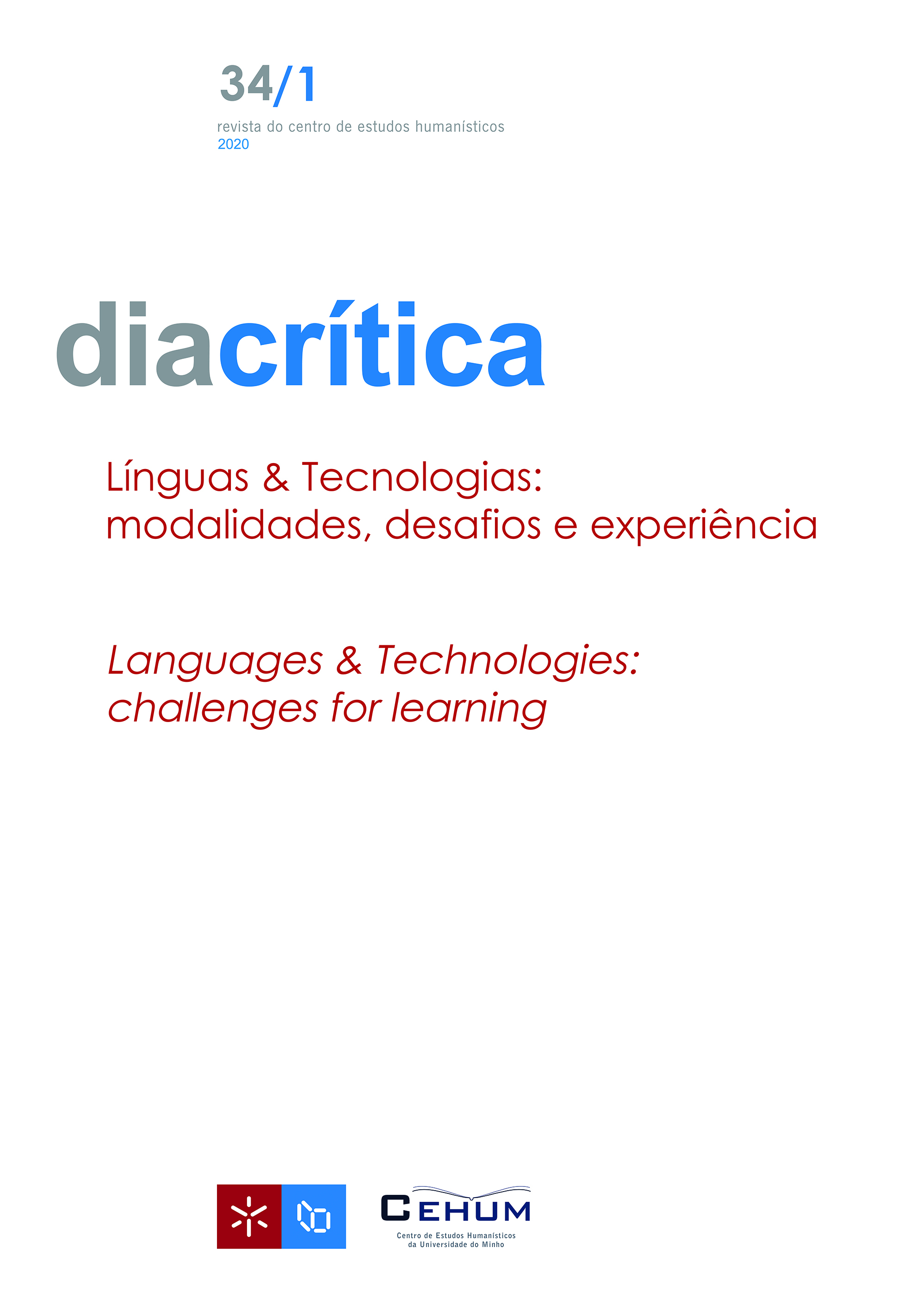Digital media in autonomous German vocabulary learning: a case study
DOI:
https://doi.org/10.21814/diacritica.4971Keywords:
German as a Foreign Language, Apps, Autonomous vocabulary learningAbstract
Foreign language vocabulary learning is a long process and demands consolidation over time. Digital media have several attributes that are especially suited for this purpose, they are interactive, mobile, flexible in use and allow the combination of different media. These are very useful attributes in the design of learning activities for students with different needs and preferences. The experience described herein concerns the tools and activities for autonomous vocabulary learning that were conceived as a complement to in class teaching to be used by students of German at the Faculty of Arts, University of Coimbra. The project participants are characterized and the appusage records are presented and analysed as well as the data extracted from the final assessment survey. Student feedback is very positive and emphasizes the attributes of digital tools.
References
Butzkamm, W. (2003). We only learn language once. The role of the mother tongue in FL classrooms: death of a dogma. Language Learning Journal, 28, 29–39. <http://www.fremdsprachendidaktik.rwth-aachen.de/Ww/programmatisches/pachl.html>. Consultado em: 25 ago. 2019. DOI: https://doi.org/10.1080/09571730385200181
Dörnyei, D. & Ushioda, E. (2011). Teaching and Researching Motivation. Harlow: Pearson Education Limited.
Feick, D. (2014). Mobile Learning – Handyprojekte im Deutsch-als-Fremdsprache-Unterricht. In N. Mackus & J. Möhring (Eds.), WEGE öffnen für Bildung, Beruf und Gesellschaft – mit Deutsch als Fremd – und Zweitsprache, 38. Jahrestagung des Fachverbandes Deutsch als Fremdsprache an der Universität Leipzig 2011 (pp. 317–332). Göttingen: Universitätsverlag.
García-Sánchez, S. & Luján-García, C. (2015). M-Learning and U-Learning Environments to Enhance EFL Communicative Competence. In Y. (A.) Zhang (Ed.), Handbook of Mobile Teaching and Learning (pp. 917–934). Berlin/Heidelberg: Springer. DOI: https://doi.org/10.1007/978-3-642-54146-9_74
González-Fernández, B. & Schmitt, N. (2017). Vocabulary Acquisition. In S. Loewen & M. Sato (Eds.), Routledge Handbook of Instructed Second Language Acquisition (pp. 280–298). New York: Routledge. DOI: https://doi.org/10.4324/9781315676968-16
Hubbard, P. (2013). Making a Case for Learner Training in Technology Enhanced Language Learning Environments. CALICO Journal, 30 (2), 163-178. <https://doi.org//10.11139/cj.30.2.163-178>. Consultado em: 21 jun. 2018. DOI: https://doi.org/10.11139/cj.30.2.163-178
Kraglund-Gauthier, W. L. (2015). Learning to Teach with Mobile Technologies: Pedagogical Implications In and Outside the Classroom. In Y. (A.) Zhang (Ed.), Handbook of Mobile Teaching and Learning (pp. 365–379). Berlin/Heidelberg: Springer. DOI: https://doi.org/10.1007/978-3-642-54146-9_68
Ma, Q. (2017). Technologies for Teaching and Learning L2 Vocabulary. In C. A. Chapelle & S. Sauro (Eds.), The Handbook of Technology and Second Language Teaching and Learning (pp. 45–61). Oxford: Wiley Blackwell. DOI: https://doi.org/10.1002/9781118914069.ch4
Mitschian, H. (2010). M-Learning – Die Neue Welle? Mobiles Lernen für Deutsch als Fremdsprache. Kassel: Kassel University Press. DOI: https://doi.org/10.26530/OAPEN_355293
Nation, I. S. P. (2006). Language education – vocabulary. In K. Brown (Ed.), Encyclopedia of Language and Linguistics (pp. 494-499). Oxford: Elsevier. DOI: https://doi.org/10.1016/B0-08-044854-2/00678-7
Soares, R., Carecho, J. & Fernandes, A. (2018). Aprender vocabulário fora das paredes da sala de aula. In M. D. Guzmán Franco, A. Pérez Escoda & R. García-Ruiz (Eds.), Dispositivos móviles en el aula: docentes y estudiantes prosumidores en la era digital (pp. 173–194). Sevilla: Egregius Ediciones.
Specht, M., Ebner, M. & Loecker, C. (2013). Mobiles und ubiquitäres Lernen. Technologien und didaktische Aspekte. In M. Ebner & S. Schön (Eds.), L3T: Lehrbuch für Lernen und Lehren mit Technologien. Frankfurt am Main: PeDocs, Deutsches Institut für Internationale Pädagogische Forschung.
Stockwell, G. (2013). Tracking learner usage of mobile phones for language learning outside of the classroom. In P. Hubbard, M. Schultz & B. Smith (Eds.), Human-computer interaction in language learning: Studies in honor of Robert Fischer (pp. 118–136). San Marcos, TX: CALICO. DOI: https://doi.org/10.1558/cj.v30i0.118-136
Stockwell, G. (2015). Digital Media Literacy in Language Teaching. Journal of Korean Language Education 36, 361-381. <https://doi.org/10.17313/jkorle.2015..36.361>. Consultado em: Consultado em: 21 jun. 2018. DOI: https://doi.org/10.17313/jkorle.2015..36.361
Stockwell, G. (2016). Mobile language learning. In F. Farr & L. Murray (Eds.), The Routledge Handbook of Language Learning and Technology [e-book] (pp. 959–997). New York: Routledge.
Stockwell, G. & Hubbard, P. (2013). Some emerging principles for mobile-assisted language learning. Monterey, CA: The International Research Foundation for English Language Education. <http://www.tirfonline.org/english-in-the-workforce/mobile-assisted-language-learning>. Consultado em: 30 jul. 2018.
Zhang, Y. (2015). Characteristics of Mobile Teaching and Learning. In Y. Zhang (Ed.), Handbook of Mobile Teaching and Learning (pp. 11–28). Berlin/Heidelberg: Springer. DOI: https://doi.org/10.1007/978-3-642-54146-9_5
Downloads
Published
How to Cite
Issue
Section
License
Copyright (c) 2023 Judite Carecho, Rute Soares, Anabela Fernandes

This work is licensed under a Creative Commons Attribution-NonCommercial 4.0 International License.










